Author Biographies 6
 James Branch Cabell
James Branch Cabell
1879-1958
James Branch Cabell (April 14, 1879-May 5, 1958) was an American author of fantasy fiction and belles lettres. During his life, Cabell published 52 books, including novels, genealogies, collections of short stories, poetry and miscellanea. He was elected to the American Academy of Arts and Sciences in 1937.
Cabell was born into an affluent and well-connected Virginian family and lived most of his life in Richmond. Although Cabell’s surname is often mispronounced “Ka-BELL,” he himself pronounced it “CAB-ble.” To remind an editor of the correct pronunciation, Cabell composed this rhyme: “Tell the rabble my name is Cabell.”
Cabell matriculated to the College of William and Mary in 1894 at the age of 15 and graduated in 1898. While an undergraduate, Cabell taught French and Greek at the College. According to his close friend and fellow author, Ellen Glasgow, Cabell developed a friendship with a professor at the college that was considered by some to be “too intimate” and, as a result, Cabell was dismissed, although he was subsequently readmitted and finished his degree. Following his graduation, he worked from 1898 to 1900 as a newspaper reporter in New York City, but returned to Richmond in 1901, where he worked several months on the staff of The Richmond News.
His first stories were accepted for publication in 1901. In 1902, seven of his first stories appeared in national magazines and over the next decade he wrote many short stories and articles, contributing to nationally published magazines, including Harper’s Monthly Magazine and The Saturday Evening Post, as well as carrying out extensive research on his family’s genealogy.
Cabell died of a cerebral hemorrhage in 1958 in Richmond. He is buried in Hollywood Cemetery in Richmond.
Source: http://en.wikipedia.org/wiki/James_Branch_Cabell
 Bibliography
Bibliography
Press your browser’s BACK button to return to the previous page.
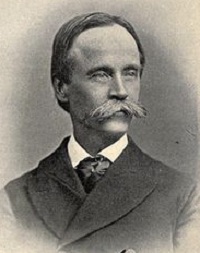 George Washington Cable
George Washington Cable
1844-1925
George Washington Cable (October 12, 1844-January 31, 1925) was an American novelist notable for the realism of his portrayals of Creole life in his native Louisiana. His fiction has been thought to anticipate that of William Faulkner.
Cable was born in New Orleans, Louisiana. He served in the Confederate Army during the American Civil War. At the end of the war in 1865, he went into journalism, writing for The New Orleans Picayune, where he would remain through 1879. By that time, he was a well-established writer. His sympathy for civil rights and opposition toward the harsh racism of the era showed in his writings, earning him resentment by many white Southerners. In 1884, Cable moved to Massachusetts. He became friends with Mark Twain and the two writers did speaking tours together.
Cable died in St. Petersburg, Florida.
Source: http://en.wikipedia.org/wiki/George_Washington_Cable
 Bibliography
Bibliography
Press your browser’s BACK button to return to the previous page.
 Caedmon
Caedmon
d. 680
Caedmon is the earliest English poet whose name is known. An Anglo-Saxon herdsman attached to the double monastery of Streonaeshalch (Whitby Abbey) during the abbacy of St. Hilda (657-680), he was originally ignorant of “the art of song” but, according to Bede, learned to compose one night in the course of a dream. He later became a zealous monk and an accomplished and inspirational religious poet.
Caedmon is one of 12 Anglo-Saxon poets identified in medieval sources, and one of only three for whom both roughly contemporary biographical information and examples of literary output have survived. His story is related in the Historia ecclesiastica gentis Anglorum (Ecclesiastical History of the English People) by St. Bede, who wrote, “[t]here was in the Monastery of this Abbess a certain brother particularly remarkable for the Grace of God, who was wont to make religious verses, so that whatever was interpreted to him out of scripture, he soon after put the same into poetical expressions of much sweetness and humility in English, which was his native language. By his verse the minds of many were often excited to despise the world, and to aspire to heaven.”
Caedmon’s only known surviving work is Caedmon’s Hymn, the nine-line alliterative vernacular praise poem in honor of God that he supposedly learned to sing in his initial dream. The poem is one of the earliest attested examples of Old English and is, with the runic Ruthwell Cross and Franks Casket inscriptions, one of three candidates for the earliest attested example of Old English poetry. It is also one of the earliest recorded examples of sustained poetry in a Germanic language.
After a long and zealously pious life, Caedmon died like a saint: Receiving a premonition of death, he asked to be moved to the abbey’s hospice for the terminally ill where, having gathered his friends around him, he expired just before nocturns. Although he is often listed as a saint, this is not confirmed by Bede and it has recently been argued that such assertions are incorrect.
Source: http://en.wikipedia.org/wiki/C%C3%A6dmon
 Bibliography
Bibliography
Press your browser’s BACK button to return to the previous page.
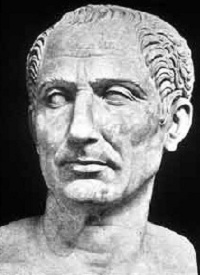 Julius Caesar
Julius Caesar
100-44 BC
Gaius Julius Caesar (July 100 BC-15 March 44 BC) was a Roman general and statesman and a distinguished writer of Latin prose. He played a critical role in the gradual transformation of the Roman Republic into the Roman Empire.
In 60 BC, Caesar, Crassus and Pompey formed a political alliance that was to dominate Roman politics for several years. Their attempts to amass power through populist tactics were opposed by the conservative elite within the Roman Senate, among them Cato the Younger, with the frequent support of Cicero. Caesar’s conquest of Gaul, completed by 51 BC, extended Rome’s territory to the English Channel and the Rhine. Caesar became the first Roman general to cross both when he built a bridge across the Rhine and conducted the first invasion of Britain. These achievements granted him unmatched military power and threatened to eclipse Pompey’s standing. The balance of power was further upset by the death of Crassus in 53 BC. Political realignments in Rome finally led to a standoff between Caesar and Pompey, the latter having taken up the cause of the Senate. Ordered by the Senate to stand trial in Rome for various charges, Caesar marched from Gaul to Italy with his legions, crossing the Rubicon in 49 BC. This sparked a civil war from which he emerged as the unrivaled leader of the Roman world.
After assuming control of government, he began extensive reforms of Roman society and government. He centralized the bureaucracy of the Republic and was eventually proclaimed “dictator in perpetuity.” A group of senators, led by Marcus Junius Brutus, assassinated the dictator on the Ides of March (15 March) 44 BC, hoping to restore the constitutional government of the Republic. However, the result was a series of civil wars, which ultimately led to the establishment of the permanent Roman Empire by Caesar’s adopted heir, Octavius (later known as Augustus).
Much of Caesar’s life is known from his own accounts of his military campaigns and other contemporary sources, mainly the letters and speeches of Cicero and the historical writings of Sallust. The later biographies of Caesar by Suetonius and Plutarch are also major sources.
Source: http://en.wikipedia.org/wiki/Julius_Caesar
 Bibliography
Bibliography
Press your browser’s BACK button to return to the previous page.
 Abraham Cahan
Abraham Cahan
1860-1951
Abraham “Abe” Cahan (July 7, 1860-August 31, 1951) was a Lithuanian-born American socialist newspaper editor, novelist and politician. He was born in Podberezhie, now part of Lithuania but then part of the Russian empire, into an Orthodox Jewish family. His grandfather was a rabbi in Vidz, Vitebsk, his father a teacher of Hebrew language and the Talmud. The family, which was devoutly religious, moved in 1866 to Wilna (Vilnius), where the young Cahan received the usual Jewish preparatory education for the rabbinate. He, however, was attracted by secular knowledge and clandestinely studied the Russian language, ultimately prevailing on his parents to allow him to enter the Teachers Institute of Wilna, from which he was graduated in 1881. He was appointed teacher in a Jewish government school in Velizh, Vitebsk, in the same year.
On March 13, 1881, Tsar Alexander II was assassinated by terrorist members of the Socialist Revolutionary Party. Reprisals by the Russian state were quick and massive. A visit from the police prompted the young socialist schoolteacher to escape to the United States through emigration.
Cahan arrived in New York City in June 1882. He transferred his commitment to socialism to his new country and devoted all the time he could spare from work to the study and teaching of radical ideas to the Jewish working men of New York. Cahan joined the Socialist Labor Party of America, writing articles on socialism and science, and translating literary works for the pages of its Yiddish language paper, The Arbeiter Zeitung (The Workers’ News). Cahan saw himself as an educator and enlightener of the impoverished Jewish working class of the city, “meeting them on their own ground and in their own language.” Cahan’s contribution to Yiddish-language socialist propaganda was massive, as before his arrival educated Jewish emigres from the old Russian empire tended to speak Russian.
During his years of activity, Cahan was either originator, collaborator or editor of almost all the earlier socialist periodicals published in Yiddish in the United States. From 1903 until 1946, Cahan ran The Jewish Daily Forward (Forverts), a socialist Yiddish-language daily in New York. In 1906 he introduced an advice column named A Bintel Brief.
Cahan quickly mastered the English language and, four years after his arrival in New York, taught immigrants in one of the evening schools. Later, he began to contribute articles to The Sun and other newspapers printed in English and was for several years employed in a literary capacity by The Commercial Advertiser, where we was a regular contributor.
His first novel, Yekl: A Tale of the New York Ghetto, was published in 1896. Cahan’s next work of fiction, The Imported Bridegroom and Other Stories, published in 1898, was also well received and favorably noticed by the general press. Of his shorter publications, an article about the Russian Jews in the United States, which appeared in The Atlantic Monthly, July 1898, deserves special mention. His other important work, The Rise of David Levinsky, was published in 1917. Cahan also wrote a five-volume Yiddish-language autobiography, Bleter fun mayn Leben, the first three volumes of which were translated into English as The Education of Abraham Cahan.
Cahan died of congestive heart failure on August 31, 1951.
Source: http://en.wikipedia.org/wiki/Abraham_Cahan
 Bibliography
Bibliography
Press your browser’s BACK button to return to the previous page.
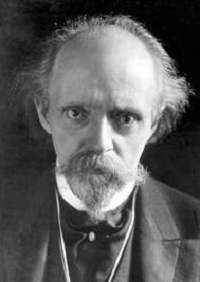 Thomas Henry Hall Caine
Thomas Henry Hall Caine
1853-1931
Sir Thomas Henry Hall Caine (May 14, 1853-August 31, 1931), usually known as Hall Caine, was a Manx author. He is best known as a novelist and playwright of the late Victorian and the Edwardian eras. In his time he was exceedingly popular and, at the peak of his success, his novels outsold those of his contemporaries. Many of his novels were also made into films. His novels were primarily romances involving love triangles, but also addressed some of the more serious political and social issues of the day.
Caine acted as secretary to Dante Gabriel Rossetti and at one time he aspired to become a man of letters. To this end he published a number of serious works, but these had little success. He was a lover of the Isle of Man and Manx culture, and purchased a large house, Greeba Castle, on the island. For a time he was a Member of the House of Keys, but he declined to become more deeply involved in politics. A man of striking appearance, he traveled widely and used his travels to provide the settings for some of his novels. He came into contact with, and was influenced by, many of the leading personalities of the day, particularly those of a socialist leaning.
Caine’s novels are considered outdated by creators of English literature curricula today and, despite his immense popularity during his life, he is now virtually unknown and unremembered.
In August 1931, at age 78, Caine slipped into a coma and died. On his death certificate was the diagnosis of “cardiac syncope.”
Source: http://en.wikipedia.org/wiki/Hall_Caine
 Bibliography
Bibliography
Press your browser’s BACK button to return to the previous page.
 Erskine Caldwell
Erskine Caldwell
1903-1987
Erskine Preston Caldwell (December 17, 1903-April 11, 1987) was an American author. His writings about poverty, racism and social problems in his native South, like the novels Tobacco Road and God’s Little Acre, won him critical acclaim, but they also made him controversial among fellow Southerners of the time who felt he was deprecating the people of the region.
Caldwell was born in a house in a wooded area outside Moreland, Georgia, the son of a minister of the Associate Reformed Presbyterian Church. During his early childhood, he was relocated from state to state across the American South, as his father found jobs in various churches.
Later, he attended but did not graduate from Erskine College. He was six feet tall, athletic and played football. His political sympathies were with the working class, and he used his experiences with common workers to write books that extolled the simple life of those less fortunate than he was. Later in life, he gave seminars on low-income tenant-sharecroppers in the American South.
His first and second published works were Bastard (1929) and Poor Fool (1930), but the works for which he is most famous are his novels, Tobacco Road (1932) and God’s Little Acre (1933).
When his first book was published, it was banned and copies were seized by authorities. Later, with the publication of God’s Little Acre, authorities, at the instigation of The New York Literary Society (apparently incensed at Caldwell’s choice of title), arrested Caldwell and seized his copies when he went to New York for a book-signing event. A trial exonerated Caldwell and he counter-sued for false arrest and malicious prosecution.
Through the 1930s, Caldwell and his first wife, Helen, managed a bookstore in Maine. Caldwell was married to photographer Margaret Bourke-White from 1939 to 1942, and they collaborated on three photo-documentaries: You Have Seen Their Faces (1937), North of the Danube (1939) and Say, Is This the USA? (1941).
During World War II, Caldwell obtained papers from the USSR that allowed him to travel to Ukraine and work as a foreign correspondent documenting the war effort there. Disillusionment with the intrigues of the Stalinist regime caused him to compose a four-page short story, “Message for Genevieve,” published on returning to the United States during 1944. After he returned from World War II, Caldwell took up residence in San Francisco.
During the last 20 years of his life, he got into the habit of traveling around the world for six months of each year, and he took with him notebooks in which to jot down his ideas. Many of these notebooks were not published, but can be examined in a museum dedicated to him. The house in which he was born was moved from its original site, preserved and was made into a museum in the town square of Moreland, Ga.
Caldwell, a heavy smoker, died from complications of emphysema and lung cancer on April 11, 1987, in Paradise Valley, Arizona. He is interred in Scenic Hills Memorial Park, Ashland, Oregon.
Source: http://en.wikipedia.org/wiki/Erskine_Caldwell
 Bibliography
Bibliography
Press your browser’s BACK button to return to the previous page.
 Morley Callaghan
Morley Callaghan
1903-1990
Morley Callaghan was born in Toronto in 1903 to Roman-Catholic parents. He attended St. Michael’s College, University of Toronto, from 1921-25. He earned a general arts degree by taking classes across a multiplicity of disciplines. He also participated in a wide variety of extra-curricular activities and worked part-time for The Toronto Star Weekly, where he met Ernest Hemingway, who became an early mentor. Although he completed a law degree in 1928, Callaghan’s first love was writing.
Callaghan’s first novel, Strange Fugitive, appeared in 1928. In 1929, he signed with a publishing house in New York to produce his first collection of short stories, A Native Argosy. He married and sailed to France, where he socialized with Hemingway, F. Scott Fitzgerald and James Joyce in Paris. During a friendly boxing match with Hemingway he knocked out the American novelist and, as a result, their friendship was never the same. Callaghan was heavily influenced by American naturalist literature, apparent in such novels as It’s Never Over (1930) and A Broken Journey (1932). His most commercially popular book came in 1934 with Such Is My Beloved. He followed with They Shall Inherit the Earth (1935), Now That April’s Here and Other Stories (1936) and More Joy in Heaven (1937). These books, with their Christian theological themes, complex characterizations and ambiguous treatment of love, established Callaghan as an important figure in North American literary circles.
The war saw his financial success wane and he began to work once again as a professional writer. He wrote for newspapers and radio in order to support his wife and two sons. He felt that his inspiration was beginning to falter. But after the deaths of three close family members, Callaghan once again turned to the redemptive power of literature. In the 1950s and 1960s, he involved himself in many aspects of writing, including working with the Writer’s Union. In 1951, he finally won a Governor-General’s Award for The Loved and the Lost. He also wrote That Summer in Paris (1963), a memoir of his summer in Paris in 1929.
During the last two decades of his life, Callaghan wrote with self-reflexive irony. He would often portray himself in his later works in a playful way and would refer to his early works and reviews. He was awarded a number of honors later in his life, including the Lorne Pierce Medal (1960) and the Order of Canada (1982). He died in Toronto in 1990. One of his sons, Barry Callaghan, is a successful writer and editor.
Source: http://www.athabascau.ca/writers/mcallaghan.html
 Bibliography
Bibliography
Press your browser’s BACK button to return to the previous page.
 Charles Stuart Calverley
Charles Stuart Calverley
1831-1884
Charles Stuart Calverley (December 22, 1831-February 17, 1884) was an English poet and wit. He was the literary father of what has been called “the university school of humor.”
He was born at Martley, Worcestershire, and given the name Charles Stuart Blayds. In 1852, his father, the Rev. Henry Blayds, resumed the old family name of Calverley, which his grandfather had exchanged for Blayds in 1807. Charles went up to Balliol College, Oxford, from Harrow School in 1850, and was soon known in Oxford as the most daring and high-spirited undergraduate of his time. He was a universal favorite, a delightful companion, a brilliant scholar and the playful enemy of all “dons.” In 1851, he won the Chancellor’s prize for Latin verse, but it is said that the entire exercise was written in an afternoon, when his friends had locked him into his rooms, refusing to let him out until he had finished what they were confident would prove the prize poem.
A year later, to avoid the consequences of a college escapade (he had been expelled from Oxford), he too changed his name to Calverley and moved to Christ’s College, Cambridge. Here he was again successful in Latin verse, the only undergraduate to have won the Chancellor’s prize at both universities. In 1856, he took second place in the first class in the Classical Tripos.
He was elected fellow of Christ’s (1858), published Verses and Translations in 1862 and was called to the bar in 1865. Injuries sustained in a skating accident prevented him from following a professional career and, during the last years of his life, he was an invalid. He died of Bright’s disease.
Source: http://en.wikipedia.org/wiki/Charles_Stuart_Calverley
 Bibliography
Bibliography
Press your browser’s BACK button to return to the previous page.
 Italo Calvino
Italo Calvino
1923-1985
Italo Calvino (October 15, 1923-September 19, 1985) was an Italian writer and novelist. Born in Santiago de Las Vegas, Cuba, to botanists Mario Calvino and Evelina Mameli, he soon moved to Italy, where his family originated and where he lived most of his life. He stayed in San Remo, in the Riviera, for some 20 years.
In 1947, Calvino graduated from Turin’s university with a thesis on Joseph Conrad and started working with the official Communist paper, L’Unita; he also had a short relationship with the Einaudi publishing house, which put him in contact with Norberto Bobbio, Natalia Ginzburg, Cesare Pavese and Elio Vittorini. With Vittorini he wrote for the weekly Il Politecnico (a cultural magazine of the university). He then left Einaudi to work mainly with L’Unita and the newborn communist weekly political magazine, Rinascita. In 1950, he worked again for the Einaudi house, where he became responsible for the literary volumes. The following year, presumably in order to verify a possibility of advancement in the communist party, he visited the Soviet Union. The reports and correspondence he produced from this visit where later collected and earned him literary prizes.
In 1952, Calvino wrote with Giorgio Bassani for Botteghe Oscure, a magazine named after the popular name of the party’s head offices, and worked for Il Contemporaneo, a Marxist weekly. It was in 1957 that Calvino unexpectedly left the Communist party; his letter of resignation (soon famous) was published in L’Unita. He found new spaces for his periodic writings in the magazines Passato e Presente and Italia Domani. Together with Vittorini, he became a co-editor of Il Menabo di letteratura, a position that he held for many years.
Despite the previously severe restrictions for foreigners holding communist views, he was allowed to visit the United States, where he stayed for six months (four of which in New York), after an invitation by the Ford Foundation. Back in Italy, and once again working for Einaudi, he started publishing some of his cosmicomics in Il Caffe, a literarian magazine.
In 1975, he was made Honorary Member of the American Academy; the following year he was awarded the Austrian State Prize for European Literature. He visited Japan and Mexico and gave lectures in several American towns. In 1981, he was awarded the prestigious French Legion d’Honneur.
In 1985, he died in Siena of a cerebral hemorrhage.
Source: http://www.biographybase.com/biography/Calvino_Italo.html
 Bibliography
Bibliography
Press your browser’s BACK button to return to the previous page.
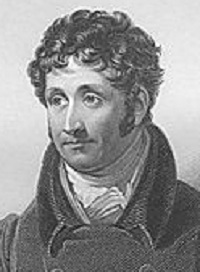 Thomas Campbell
Thomas Campbell
1777-1844
Thomas Campbell (July 27, 1777-June 15, 1844) was a Scottish poet chiefly remembered for his sentimental poetry dealing specially with human affairs. He was also one of the initiators of a plan to found what became the University of London. In 1799, he wrote “The Pleasures of Hope,” a traditional 18th century survey in heroic couplets. He also produced several stirring patriotic war songs: “Ye Mariners of England,” “The Soldier’s Dream,” “Hohenlinden” and, in 1801, “The Battle of Baltic.”
Born in Glasgow, Campbell was the youngest son of Alexander Campbell, of the Campbells of Kirnan, Argyll. His father belonged to a Glasgow firm trading in Virginia and lost his money in consequence of the American Revolutionary War. Campbell, who was educated at the Glasgow High School and University of Glasgow, won prizes for classics and for verse-writing. He spent the holidays as a tutor in the western Highlands. His poem, “Glenara,” and the “Ballad of Lord Ullin’s Daughter” owe their origin to a visit to Mull. In May 1797, he went to Edinburgh to attend lectures on law. He supported himself by private teaching and by writing. These early days in Edinburgh influenced such works as “The Wounded Hussar,” “The Dirge of Wallace” and the “Epistle to Three Ladies.”
In 1799, “The Pleasures of Hope” was published. During a tour of Germany, he wrote some of his best lyrics: “Hohenlinden,” “Ye Mariners of England” and “The Soldier’s Dream.” In 1809, he published a narrative poem in the Spenserian stanza, “Gertrude of Wyoming,” with which were printed some of his best lyrics.
In 1812, he delivered a series of lectures on poetry in London at the Royal Institution and was urged by Sir Walter Scott to become a candidate for the chair of literature at Edinburgh University. His pecuniary anxieties were relieved in 1815 by a legacy of £4000. He continued to occupy himself with his Specimens of the British Poets, the design of which had been projected years before. The work was published in 1819. In 1820, he accepted the editorship of The New Monthly Magazine and, in the same year, made another tour in Germany.
Four years later appeared his “Theodric,” a not very successful poem of domestic life. He was elected Lord Rector of Glasgow University (1826-1829) in competition against Sir Walter Scott. In 1834, he traveled to Paris and Algiers, where he wrote his “Letters from the South” (printed 1837). Campbell’s other works include a Life of Mrs. Siddons (1842) and a narrative poem, “The Pilgrim of Glencoe” (1842).
He died at Boulogne in 1844 and was buried in Westminster Abbey.
Source: http://en.wikipedia.org/wiki/Thomas_Campbell_%28poet%29
 Bibliography
Bibliography
Press your browser’s BACK button to return to the previous page.
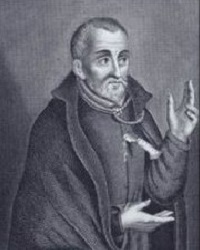 Thomas Campion
Thomas Campion
1567-1620
Born in London on February 12, 1567, to John and Lucy Campion, Thomas Campion was a physician, a composer and a poet. His parents died while he was a child and, at the age of 14, he and a step-brother were sent away to Cambridge. Campion did not earn a degree at Cambridge, but he came into contact with writers such as Thomas Nashe and Gabriel Harvey. In 1586, he enrolled at Gray’s Inn, a law school, where he performed in plays and masques. The facts of his life from this time until 1602 remain vague; in 1602, Campion entered the University of Caen and, shortly thereafter, at the age of 40, took up a medical practice in London.
His first published works were five songs, which appeared in 1591. Campion’s first collection of poems, Thomae Campiani Poemata, was published in Latin in 1595. The book included more than 129 epigrams as well as a number of elegies and an incomplete epic poem. The epigrams show Campion’s ability to draw a portrait in a few precise lines; he would later publish 453 epigrams in Epigrammatum Libri II (1619).
By 1597, Campion had focused his attention almost completely on writing the words and music for songs. In 1601, he contributed 21 songs and a brief treatise on song to the Philip Rosseter’s Book of Ayeres. Rosseter was King James I’s lutenist. Campion would publish four more books of ayeres, or solo songs, including “Light Conceits of Lovers” (1613) and The Third and Fourth Booke of Ayres (circa 1617).
Campion’s book of prosody, Observations in the Art of English Posie, was published in 1602. In it, he explored the relationship of music and poetry, and warned against “the childish titillation of rhyming.” Campion also wrote a number of libretti for masques performed in King James’ court, including Lord Hay’s Masque (1607) and The Squire’s Masque (1614). These works, commissioned by King James, allowed Campion to associate with many of England’s artistic and aristocratic elite.
Campion died on March 1, 1620, in London, probably of the plague, and was buried at St. Dunstan’s-in-the-West, Fleet Street.
Source: http://www.poets.org/poet.php/prmPID/293
 Bibliography
Bibliography
Press your browser’s BACK button to return to the previous page.
 Albert Camus
Albert Camus
1913-1960
Albert Camus was born on November 7, 1913, in Mondovi, Algeria, then part of France.
His schooling was completed only with help from scholarships. At the University of Algiers, he was a brilliant student of philosophy, focusing on the comparison of Hellenism and Christianity. Camus is described as both a physical and mental athlete. While still a student, he founded a theater and both directed and acted in plays. At 17 he contracted tuberculosis, which kept him from further sports, the military and teaching jobs.
Camus worked at various jobs before becoming a journalist in 1938. His first published works were L’Envers et l’endroit (1937; The Wrong Side and the Right Side) and Noces (1938; Festivities), books of essays dealing with the meaning of life and its joys, as well as its underlying meaninglessness. His first novel, L’Etranger (The Stranger), published in 1942, focuses on the negative aspect of man.
Unable to find work in France during World War II because Germany invaded and occupied France, Camus returned to Algeria in 1941 and finished his next book, Le Mythe de Sisyphe (The Myth of Sisyphus), also published in 1942. Back in France that year, Camus joined a Resistance group and engaged in underground journalism until the Liberation in 1944, when he became editor of the former Resistance newspaper, Combat, for three years. Also during this period his first two plays were staged: Le Malentendu (Cross-Purpose) in 1944 and Caligula in 1945. In 1947, Camus published his second novel, La Peste (The Plague). Camus’ next important book was L’Homme revolte (1951; The Rebel).
In 1957, Camus received the great honor of the Nobel Prize in Literature for his works. In the same year he began to work on a fourth important novel and was also about to become the director of a major Paris theater when, on January 4, 1960, he was killed in a car crash near Paris. He was 46 years old.
Source: http://www.notablebiographies.com/Ca-Ch/Camus-Albert.html
 Bibliography
Bibliography
Press your browser’s BACK button to return to the previous page.
 Truman Capote
Truman Capote
1924-1984
Truman Streckfus Persons was born on September 24, 1924, in New Orleans, Louisiana. His parents, Archulus Persons and Lillie Mae Faulk, were divorced when he was four years old. He lived with relatives in Monroeville, Alabama, while his mother and her second husband, Cuban businessman Joseph Capote, lived in New York.
His closest friends at this time were an elderly cousin, Miss Sook Faulk, and a neighboring tomboy, Harper Lee (1926-). She later became an award-winning author herself, writing To Kill a Mockingbird. Both friends appear as characters in Capote’s early fiction.
When he was nine years old, his mother brought her son to live in Manhattan, New York. He then took on his adopted last name, Capote. He continued to spend summers in the South. He did poorly in school, even though psychological tests proved that his Intelligence Quotient (IQ) was above genius level. Capote developed an outgoing personality to hide his loneliness and unhappiness.
Capote began secretly writing at an early age. When he completed high school, he worked for The New Yorker. There he wrote articles and short stories. When he was 17, several magazines published his short stories. That exposure eventually led to a contract to write his first novel, Other Voices, Other Rooms.
Many of Capote’s early stories were written when he was in his teens and early 20s. Collected in A Tree of Night and Other Stories, these stories show the influence of Gothic writers such as Edgar Allan Poe, Nathaniel Hawthorne and William Faulkner.
In some of Capote’s works of the 1950s, his attention is turned away from traditional fiction. In Local Color, he wrote a collection of pieces retelling his impressions and experiences while in Europe. In The Muses Are Heard: An Account, he wrote essays about his travels in Russia with a touring theater company that presented the play, Porgy and Bess.
Before Capote found his main subject, he published one more traditional novel, Breakfast at Tiffany’s. It was an engaging story of Manhattan playgirl Holly Golightly. From these projects, Capote developed the idea of creating work that would combine fact and fiction. The result was In Cold Blood.
In the late 1960s Capote began suffering from writer’s block. He spent most of his time revising or throwing out his works in progress. During the mid-1970s he published several chapters of Answered Prayers in Esquire magazine.
In 1983, Music for Chameleons, a final collection of short prose pieces, was published. Afterward, Capote took to alcohol, drug addiction and suffered poor health. He died in Los Angeles, California, on August 24, 1984, shortly before his 60th birthday.
Source: http://www.notablebiographies.com/Ca-Ch/Capote-Truman.html
 Bibliography
Bibliography
Press your browser’s BACK button to return to the previous page.
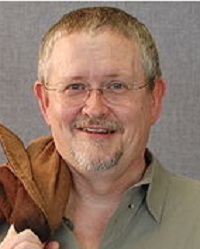 Orson Scott Card
Orson Scott Card
1951-
Orson Scott Card (born August 24, 1951) is an American author, critic, public speaker, essayist, columnist and political activist. He writes in several genres but is primarily known for his science fiction. His novel, Ender’s Game (1985), and its sequel, Speaker for the Dead (1986), both won Hugo and Nebula Awards, making Card the only author to win both of science fiction’s top U.S. prizes in consecutive years.
Card is the son of Willard and Peggy Card, third of six children and the older brother of composer and arranger Arlen Card. He was born in Richland, Washington, and grew up in Santa Clara, California, as well as Mesa, Arizona, and Orem, Utah. He served as a missionary for The Church of Jesus Christ of Latter-day Saints (LDS Church) in Brazil and graduated from Brigham Young University and the University of Utah; he also spent a year in a Ph.D. program at the University of Notre Dame.
Card lives in Greensboro, North Carolina, an environment that played a significant role in Ender’s Game and many of his other works.
Source: http://en.wikipedia.org/wiki/Orson_Scott_Card
 Bibliography
Bibliography
Press your browser’s BACK button to return to the previous page.
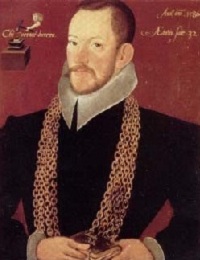 Richard Carew
Richard Carew
1555-1620
Richard Carew, English poet and antiquary, was born on July 17, 1555, at Antony House, East Antony, Cornwall. At the age of 11, he entered Christ Church, Oxford, and when only 14 was chosen to carry on an extempore debate with Sir Philip Sidney, in presence of the earls of Leicester and Warwick and other noblemen. From Oxford he removed to the Middle Temple, where he spent three years, and then went abroad. By his marriage with Juliana Arundel in 1577 he added Coswarth to the estates he had already inherited from his father.
In 1586, he was appointed high-sheriff of Cornwall. He entered parliament in 1584 and served under Sir Walter Raleigh, then lord lieutenant of Cornwall, as treasurer. He became a member of the Society of Antiquaries in 1589 and was a friend of William Camden and Sir Henry Spelman.
His great work is The Survey of Cornwall, published in 1602, and reprinted in 1769 and 1811. It still possesses interest, apart from its antiquarian value, for the picture it gives of the life and interests of a country gentleman in the days of Elizabeth I.
Carew’s other works are: a translation of the first five Cantos of Tasso’s Gerusalemme (1594), printed in the first instance without the author’s knowledge, and entitled Godfrey of Balloigne, or the Recouerie of Hierusalam; The Examination of Men’s Wits (1594), a translation of an Italian version of John Huarte’s Examen de Ingenios; and An Epistle Concerning the Excellences of the English Tongue (1605).
Carew died on November 6, 1620.
Source: http://www.1911encyclopedia.org/Richard_Carew
 Bibliography
Bibliography
Press your browser’s BACK button to return to the previous page.
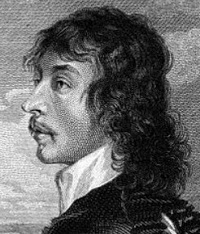 Thomas Carew
Thomas Carew
1594-1640
Thomas Carew (pronounced Carey) was born, possibly at West Wickham, Kent, in either 1594 or 1595. His father, lawyer Matthew Carew, moved the family to London about 1598. Nothing is known of Carew’s education before he matriculated at Merton College, Oxford, in 1608. Graduating B.A. in 1610/11, he was incorporated B.A. of Cambridge in 1612, after which he was admitted to the Middle Temple. From 1613 to 1616 Carew served as secretary to Sir Dudley Carleton on embassies to Italy and the Netherlands. After being fired for making insulting remarks about Carleton and his wife, Carew returned to England in a futile search for employment. In 1619, his father having died the previous year, Carew joined an embassy to Paris headed by Sir Edward Herbert (later Lord Herbert of Chirbury). Possibly, he met there the Italian poet Giambattista Marino.
In 1622, Carew’s first poem was published: “Verses prefixed to Thomas May’s comedy, The Heir.” In the early 1620s Carew associated with Ben Jonson and his circle and also frequented the court. In 1630, Carew was made a gentleman of Charles I’s Privy Chamber Extraordinary. He was named Sewer in Ordinary to the King (that is, an official in charge of the royal dining arrangements). It is said he was “high in favour with that king, who had a high opinion of his wit and abilities.”
This reputation did nothing to damage his career as a poet, soldier and courtier. His society verses, such as “A Divine Mistress” and “Disdain Returned,” were prized for their wit. Carew’s masque, Coelum Britannicum, performed before the king in 1634, though full of jokes and allusions, draws upon an important work by the 16th century Italian philosopher Giordano Bruno. Much of Carew’s poetry was sexually explicit far beyond the norms of his age, and he was a reputed libertine. Yet he translated nine of the Psalms and wrote one of the finest elegies of the period: “An Elegy on the Death of the Dean of St. Paul’s, Dr. John Donne.”
Perhaps the most interesting of Carew’s achievements is his verse criticism of his contemporaries. Formal criticism was in its infancy during the early 17th century. Carew’s commendatory, complimentary and elegiac poems provide some of the best evidence concerning the literary values of the age.
Carew died on March 23, 1640, and was buried in St. Dunstan’s-in-the-West, Westminster. His Poems were published the same year, to be followed by the second edition “revised and enlarged” in 1642.
Source: http://www.luminarium.org/sevenlit/carew/carewbio.htm
 Bibliography
Bibliography
Press your browser’s BACK button to return to the previous page.
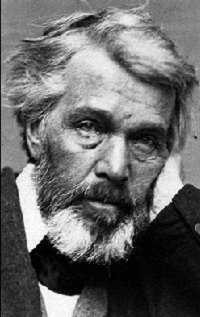 Thomas Carlyle
Thomas Carlyle
1795-1881
Thomas Carlyle (December 4, 1795-February 5, 1881) was a Scottish satirical writer, essayist, historian and teacher during the Victorian era. He called economics “the dismal science,” wrote articles for the Edinburgh Encyclopedia and became a controversial social commentator.
Coming from a strict Calvinist family, Carlyle was expected by his parents to become a preacher but, while at the University of Edinburgh, he lost his Christian faith. Calvinist values, however, remained with him throughout his life. This combination of a religious temperament with loss of faith in traditional Christianity made Carlyle’s work appealing to many Victorians who were grappling with scientific and political changes that threatened the traditional social order.
Carlyle was born in Ecclefechan, Dumfries and Galloway. His parents determinedly afforded him an education at Annan Academy, Annan, where he was bullied and tormented so much that he left after three years. After attending the University of Edinburgh, Carlyle became a mathematics teacher, first in Annan and then in Kirkcaldy.
In 1819-1821, Carlyle returned to the University of Edinburgh, where he suffered an intense crisis of faith and conversion that would provide the material for Sartor Resartus (The Tailor Retailored), which first brought him to the public’s notice. He began reading deeply in German literature. Carlyle’s thinking was heavily influenced by German Idealism, in particular the work of Johann Gottlieb Fichte. He established himself as an expert on German literature in a series of essays for Fraser’s Magazine and by translating German writers, notably Goethe (the novel, Wilhelm Meisters Lehrjahre). He also wrote Life of Schiller (1825).
His residence for much of his early life, after 1828, was a farm in Craigenputtock and a house in Dumfrieshire, Scotland, where he wrote many of his works, including some of his most distinguished essays, and he began a lifelong friendship with the American essayist Ralph Waldo Emerson.
In 1834, Carlyle moved to the Chelsea section of London, where he was then known as the “sage of Chelsea” and became a member of a literary circle that included the essayists Leigh Hunt and John Stuart Mill. In London, Carlyle wrote The French Revolution, A History (1837), as a historical study concerning oppression of the poor, which was immediately successful.
His last major work was the epic Life of Frederick the Great (1858-65). Later writings were generally short essays, often indicating the hardening of Carlyle’s political positions. In 1866, Thomas Carlyle partly retired from active society. He was appointed rector of the University of Edinburgh.
Carlyle died on February 5, 1881 in London.
Source: http://en.wikipedia.org/wiki/Thomas_Carlyle
 Bibliography
Bibliography
Press your browser’s BACK button to return to the previous page.
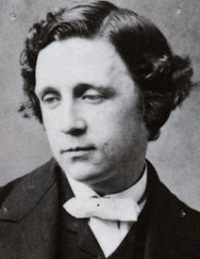 Lewis Carroll
Lewis Carroll
1832-1898
Lewis Carroll was born Charles Lutwidge Dodgson on January 27, 1832, the eldest son and third of 11 children born to Frances Jane Lutwidge and the Reverend Charles Dodgson. Carroll had a happy childhood. His mother was patient and gentle; his father, despite his religious duties, tutored all of his children and raised them to be good people. Carroll frequently made up games and wrote stories and poems, some of which were similar to his later published works, for his seven sisters and three brothers.
Although his years at Rugby School (1846-49) were unhappy, he was recognized as a good student and in 1850 he was admitted to further study at Christ Church, Oxford, England. He graduated in 1854; in 1855, he became mathematical lecturer at the college. This permanent appointment, which not only recognized his academic skills but also paid him a decent sum, required Carroll to take holy orders in the Anglican Church and to remain unmarried. He agreed to these requirements and was made a deacon in 1861.
Among adults, Carroll was reserved but he did not avoid their company as some reports have stated. He attended the theater frequently and was absorbed by photography and writing. In the mid-1850s Carroll also began writing both humorous and mathematical works. In 1856, he created the pseudonym “Lewis Carroll” by translating his first and middle names into Latin, reversing their order, then translating them back into English. His mathematical writing, however, appeared under his real name.
In 1856, Carroll met Alice Liddell, the four-year-old daughter of the head of Christ Church. During the next few years, Carroll often made up stories for Alice and her sisters. In July 1862, while on a picnic with the Liddell girls, Carroll recounted the adventures of a little girl who fell into a rabbit hole. Alice asked him to write the story out for her. He did so, calling it Alice’s Adventures under Ground. After some changes, this work was published in 1865 as Alice’s Adventures in Wonderland.
Encouraged by the book’s success, Carroll wrote a second volume, Through the Looking Glass and What Alice Found There (1872). Based on the chess games Carroll played with the Liddell children, it included material he had written before he knew them. The first section of Jabberwocky, for example, was written in 1855. More of Carroll’s famous Wonderland characters – such as Humpty Dumpty, the White Knight, and Tweedledum and Tweedledee – appear in this work than in Alice in Wonderland.
Carroll published several other nonsense works, including The Hunting of the Snark (1876), Sylvie and Bruno (1889) and Sylvie and Bruno Concluded (1893). He also wrote a number of pamphlets poking fun at university affairs, which appeared under a fake name or without any name at all, and he composed several works on mathematics under his true name. In 1881, Carroll gave up his lecturing to devote all of his time to writing. From 1882 to 1892, however, he was curator of the common room at Christ Church.
After a short illness, he died on January 14, 1898.
Source: http://www.notablebiographies.com/Ca-Ch/Carroll-Lewis.html
 Bibliography
Bibliography
Press your browser’s BACK button to return to the previous page.
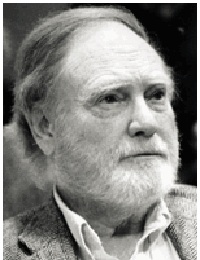 Hayden Carruth
Hayden Carruth
1921-2008
Hayden Carruth was born on August 3, 1921, in Waterbury, Connecticut, and educated at both the University of North Carolina at Chapel Hill and the University of Chicago, where he earned a master’s degree.
His first collection of poems, The Crow and the Heart, was published in 1959. Since then, he published more than 30 books, including Toward the Distant Islands: New and Selected Poems (2006) and Doctor Jazz: Poems 1996-2000 (2001).
Other poetry titles include Scrambled Eggs & Whiskey: Poems, 1991-1995 (1996), which received the National Book Award for Poetry; Collected Longer Poems (1994); Collected Shorter Poems, 1946-1991 (1992), which received the National Book Critics’ Circle Award; The Sleeping Beauty (1990); and Tell Me Again How the White Heron Rises and Flies across Nacreous River at Twilight Toward the Distant Islands (1989).
Known also for his criticism, Carruth is the author of several prose collections, including Selected Essays & Reviews (1996) and Sitting In: Selected Writings on Jazz, Blues and Related Topics (1993), as well as nonfiction works, including Beside the Shadblow Tree: A Memoir of James Laughlin (1999) and Reluctantly: Autobiographical Essays (1998).
He is also the author of a novel, Appendix A (1963), and has edited a number of anthologies, including The Voice That Is Great Within Us: American Poetry of the Twentieth Century (1970).
Informed by his political radicalism and sense of cultural responsibility, many of Carruth’s best-known poems are about the people and places of northern Vermont, as well as rural poverty and hardship.
Carruth received fellowships from the Bollingen Foundation, the Guggenheim Foundation and the National Endowment for the Arts, and a 1995 Lannan Literary Fellowship. He was presented with the Lenore Marshall Award, the Paterson Poetry Prize, the Vermont Governor’s Medal, the Carl Sandburg Award, the Whiting Award and the Ruth Lilly Prize, among many others.
He taught at Bucknell University in Lewisburg, Pennsylvania, and at the Graduate Creative Writing Program at Syracuse University.
Carruth lived in Vermont for many years before residing in Munnsville, New York, with his wife, the poet Joe-Anne McLaughlin Carruth. He died September 29, 2008.
Source: http://www.poets.org/poet.php/prmPID/232
 Bibliography
Bibliography
Press your browser’s BACK button to return to the previous page.
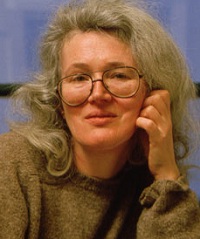 Angela Carter
Angela Carter
1940-1992
Angela Carter (May 7, 1940-February 16, 1992) was an English novelist and journalist, known for her feminist, magical realism and picaresque works.
Born Angela Olive Stalker in Eastbourne, in 1940, Carter was evacuated as a child to live in Yorkshire with her maternal grandmother. She began work as a journalist on the Croydon Advertiser, following in the footsteps of her father. Carter attended the University of Bristol, where she studied English literature.
She married twice, first in 1960 to Paul Carter. They separated in 1970. In 1969 Carter used the proceeds of her Somerset Maugham Award to leave her husband and relocate for two years to Tokyo, Japan, where she claims in Nothing Sacred (1982) that she “learnt what it is to be a woman and became radicalized.” She wrote about her experiences there in articles for New Society and a collection of short stories, Fireworks: Nine Profane Pieces (1974), and evidence of her experiences in Japan can also be seen in The Infernal Desire Machines of Doctor Hoffman (1972). She then explored the United States, Asia and Europe, helped by her fluency in French and German. She spent much of the late 1970s and 1980s as a writer in residence at universities, including the University of Sheffield, Brown University, the University of Adelaide and the University of East Anglia. In 1977, Carter married Mark Pearce, with whom she had one son.
As well as being a prolific writer of fiction, Carter contributed many articles to The Guardian, The Independent and New Statesman, collected in Shaking a Leg. Her screenplays are published in the collected dramatic writings, The Curious Room, together with her radio scripts, a libretto for an opera of Virginia Woolf’s Orlando, an unproduced screenplay entitled The Christchurch Murders (based on the same true story as Peter Jackson’s Heavenly Creatures) and other works. Her novel, Nights at the Circus, won the 1984 James Tait Black Memorial Prize for literature.
Angela Carter died aged 51 in 1992 at her home in London after developing lung cancer.
Source: http://en.wikipedia.org/wiki/Angela_Carter
 Bibliography
Bibliography
Press your browser’s BACK button to return to the previous page.
 Raymond Carver
Raymond Carver
1938-1988
Raymond Clevie Carver Jr. (May 25, 1938-August 2, 1988) was an American short story writer and poet. Carver is considered a major American writer of the late 20th century and also a major force in the revitalization of the short story in the 1980s.
Carver was born in Clatskanie, Oregon, a mill town on the Columbia River, and grew up in Yakima, Washington. His father, a skilled sawmill worker from Arkansas, was a fisherman and a heavy drinker. Carver’s mother worked on and off as a waitress and a retail clerk. His one brother, James Franklin Carver, was born in 1943.
Carver was educated at local schools in Yakima, Washington. In June 1957, aged 19, he married 16-year-old Maryann Burk, who had just graduated from a private Episcopal school for girls. Their daughter, Christine La Rae, was born in December 1957. When their second child, a boy named Vance Lindsay, was born the next year, Carver was 20. Carver supported his family by working as a janitor, sawmill laborer, delivery man and library assistant. During their marriage, Maryann worked as a waitress, salesperson, administrative assistant and high school English teacher.
Carver became interested in writing in California, where he had moved with his family because his mother-in-law had a home in Paradise. Carver attended a creative-writing course taught by the novelist John Gardner, who became a mentor and had a major influence on Carver’s life and career. Carver continued his studies first at Chico State University and then at Humboldt State College in Arcata, California, where he studied with Richard Cortez Day and received his B.A. in 1963. During this period, he was first published and served as editor for Toyon, the university literary magazine, in which he included several of his own pieces under pseudonyms. He later attended the Iowa Writers’ Workshop, at the University of Iowa, for one year. Maryann graduated from San Jose State College in 1970 and taught English at Los Altos High School until 1977.
His first published story, “The Furious Seasons,” appeared in 1960. His first collection, Will You Please Be Quiet, Please?, was first published in 1976; the title story appeared in the Best American Short Stories 1976 collection.
In the mid-1960s Carver and his family lived in Sacramento, where he worked as a night custodian at Mercy Hospital. In 1967 he moved his family to Palo Alto, California, so that he could take a job as a textbook editor for Science Research Associates. He worked there until he was fired in 1970 for his inappropriate writing style. In the 1970s and 1980s, as his writing career began to take off, Carver taught for several years at universities throughout the United States.
During his years of working different jobs, rearing children and trying to write, Carver started to drink heavily. By his own admission, eventually he more or less gave up writing and took to full-time drinking. After being hospitalized three times (between June 1976 and February or March 1977), Carver began his “second life” and stopped drinking on June 2, 1977, with the help of Alcoholics Anonymous.
Carver was nominated again in 1984 for his third major press collection, Cathedral, the volume generally perceived as his best. Included in the collection are the award-winning stories, “A Small, Good Thing” and “Where I’m Calling From.”
On August 2, 1988, Carver died in Port Angeles, Washington, from lung cancer at the age of 50. In the same year, he was inducted into the American Academy of Arts and Letters.
Source: http://en.wikipedia.org/wiki/Raymond_Carver
 Bibliography
Bibliography
Press your browser’s BACK button to return to the previous page.
 Alice and Phoebe Cary
Alice and Phoebe Cary
1820-1871/1824-1871
Born near Cincinnati, Ohio, Alice on April 26, 1820, and Phoebe on September 4, 1824, the Cary sisters grew up on a farm and received little schooling. Nevertheless, they were for their time well educated, Alice by their mother and Phoebe by Alice, and they early developed a taste for literature.
Alice’s first published poem appeared in The Sentinel, a Cincinnati Universalist newspaper, when she was 18; for 10 years thereafter she continued to contribute poems and prose sketches to various periodicals with no remuneration. Phoebe began to write under Alice’s guidance and had her first poem published in a Boston newspaper about the time of Alice’s first. Their work attracted the favorable notice of Edgar Allan Poe, Horace Greeley, John Greenleaf Whittier and Rufus W. Griswold, through whose recommendation their joint works were issued as Poems of Alice and Phoebe Carey [sic] (1850). Some two-thirds of the poetry was the work of Alice. Their book’s modest success encouraged the sisters to move to New York City.
In New York City, Alice and Phoebe became regular contributors to Harper’s, The Atlantic Monthly and other periodicals. Alice, much more prolific than her sister, enjoyed the higher reputation during her lifetime, although Phoebe was later held in greater critical esteem for the wit and feeling of her poems. Their salon became a popular meeting place for the leading literary lights of New York, and both women were famed for their hospitality.
Among Alice’s books were two volumes of reminiscent sketches entitled Clovernook Papers (1852, 1853), three novels and several volumes of poetry. Phoebe devoted much of her time to keeping house and, in later years, to caring for Alice. As a result, she published only Poems and Parodies (1854) and Poems of Faith, Hope and Love (1868), but one of her religious verses, “Nearer Home” (sometimes called, from the first line, “One Sweetly Solemn Thought”), became widely popular as a hymn.
Both sisters supported the women’s rights movement. Phoebe was for a short time an assistant editor of Susan B. Anthony’s paper, The Revolution. In 1868, Alice reluctantly agreed to serve as first president of Sorosis, the pioneer women’s club founded by Jane Croly. After a long illness, Alice died in New York City on February 12, 1871; exhausted by grief and stricken with malaria, Phoebe died on July 31, 1871, in Newport, Rhode Island.
Source: http://www.csustan.edu/english/reuben/pal/chap3/cary.html
 Bibliography
Bibliography
Press your browser’s BACK button to return to the previous page.
 Elizabeth Cary
Elizabeth Cary
1585-1639
Elizabeth Cary, Lady Falkland, nee Tanfield, was an English poet, translator and dramatist. Precocious and studious, she was known from a young age for her learning and knowledge of languages.
At the age of 17, she married Henry Cary, 1st Viscount Falkland, and over the next decades she bore 11 children, including Lucius Cary, 2nd Viscount Falkland and Patrick Cary. She was disinherited by her father for using part of her jointure to meet expenses, and the family were in financial difficulties from thereon. Her husband abandoned her to poverty in 1626 and denied her access to their children when she made public her conversion to Catholicism. Despite several orders of the Privy Council, he refused her a maintenance in an apparent effort to force her to recant. She lived in abject circumstances, though she still managed to maintain connections with a constellation of politically prominent women. Her husband died in 1633 and she sought to regain custody of her children. She was questioned in the Star Chamber for kidnapping her sons (she had previously, and more easily, gained custody of her daughters), but although she was threatened with imprisonment there is no record of any punishment.
She is best known now for The Tragedy of Mariam, the Fair Queen of Jewry (1613), the first original play in English known to have been written by a woman. She was also the first English woman author to be the subject of a literary biography – The Lady Falkland: Her Life was written by one of her daughters, probably in the 1643-50 era, though not published till 1861.
Cary died in London in 1639.
Source: http://en.wikipedia.org/wiki/Elizabeth_Cary,_Lady_Falkland
 Bibliography
Bibliography
Press your browser’s BACK button to return to the previous page.
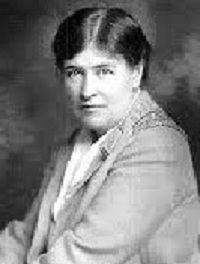 Willa Cather
Willa Cather
1873-1947
Willa Sibert Cather (December 7, 1873-April 24, 1947) was an American author who achieved recognition for her novels of frontier life on the Great Plains, in works such as O Pioneers!, My Antonia and The Song of the Lark. In 1923, she was awarded the Pulitzer Prize for One of Ours (1922), a novel set during World War I.
Cather was born on her maternal grandmother’s farm in the Back Creek Valley near Winchester, Virginia. Her father was Charles Fectigue Cather (d. 1928), whose family had lived on land in the valley for six generations. Her mother was Mary Virginia Boak (d. 1931), a former school teacher. Within a year of Cather’s birth, the family moved to Willow Shade, a Greek Revival-style home on 130 acres given to them by her paternal grandparents.
The Cathers moved to Nebraska in 1883, joining Charles’ parents, when Willa was nine years old. Her father tried his hand at farming for 18 months, then he moved the family into the town of Red Cloud, where he opened a real estate and insurance business and the children attended school for the first time. Cather’s time in the western state, still on the frontier, was a deeply formative experience for her. She was intensely moved by the dramatic environment and weather, and the various cultures of the European-American, immigrant and Native American families in the area. Her town was named for the renowned Oglala Lakota chief.
Cather had planned to major in science at the University of Nebraska – she hoped to become a medical doctor. After her essay about Thomas Carlyle was published in The Nebraska State Journal during her freshman year, she became a regular contributor to The Journal, changed her major and graduated in 1894 with a B.A. in English.
In 1896, Cather moved to Pittsburgh after being hired to write for The Home Monthly, a women’s magazine patterned after the successful Ladies Home Journal. A year later, she became a telegraph editor and drama critic for The Pittsburgh Leader and frequently contributed poetry and short fiction to The Library, another local publication. In Pittsburgh, she taught Latin, algebra and English composition at Central High School for one year. She next taught English and Latin at Allegheny High School, where she became the head of the English department.
In 1906, Cather moved to New York City upon receiving a job offer on the editorial staff from McClure’s Magazine. During her first year at McClure’s, she wrote a critical biography of Christian Science founder, Mary Baker Eddy. Mary Baker Eddy: The Story of Her Life and the History of Christian Science was published in McClure’s in 14 installments over the next 18 months and later in book form.
McClure’s serialized Cather’s first novel, Alexander’s Bridge (1912). Cather followed Alexander’s Bridge with her Prairie Trilogy: O Pioneers! (1913), The Song of the Lark (1915) and My Antonia (1918). Through the 1910s and 1920s, Cather was firmly established as a major American writer, receiving the Pulitzer Prize in 1922 for her novel, One of Ours.
Cather died on April 24, 1947 in New York City of a cerebral hemorrhage and was buried in the Old Burying Ground in Jaffrey, New Hampshire.
Source: http://en.wikipedia.org/wiki/Willa_Cather
 Bibliography
Bibliography
Press your browser’s BACK button to return to the previous page.
 Gaius Valerius Catullus
Gaius Valerius Catullus
84-54 BC
Gaius Valerius Catullus (ca. 84 BC-ca. 54 BC) was a Latin poet of the Republican period. His surviving works are still read widely and continue to influence poetry and other forms of art.
Catullus came from a leading equestrian family of Verona in Cisalpine Gaul and, according to St. Jerome, he was born in the town. The family was prominent enough for his father to entertain Caesar, then proconsul of both Gallic provinces. In one of his poems, Catullus describes his happy return to the family villa at Sirmio on Lake Garda near Verona. The poet also owned a villa near the fashionable resort of Tibur (modern Tivoli).
The poet appears to have spent most of his young adult years in Rome. A number of prominent contemporaries appear in his poetry, including Cicero, Caesar and Pompey.
He spent the provincial command year summer 57 to summer 56 BC in Bithynia on the staff of the commander, Gaius Memmius. While in the East, he traveled to the Troad to perform rites at his brother’s tomb, an event recorded in a moving poem.
There survives no ancient biography of Catullus: His life has to be pieced together from scattered references to him in other ancient authors and from his poems. Thus, it is uncertain when he was born and when he died. St. Jerome says that he died in his 30th year, and was born in 87 BC. But the poems include references to events of 55 and 54 BC. Since the Roman consular fasti make it somewhat easy to confuse 87-57 BC with 84-54 BC, many scholars accept the dates 84 BC-54 BC, supposing that his latest poems and the publication of his Libellus coincided with the year of his death.
Source: http://en.wikipedia.org/wiki/Catullus
 Bibliography
Bibliography
Press your browser’s BACK button to return to the previous page.
 Margaret Cavendish (Duchess of Newcastle)
Margaret Cavendish (Duchess of Newcastle)
1623-1673
In 1623 in Colchester, Essex, Sir Thomas Lucas and his wife Elizabeth had their eighth child, a daughter they named Margaret. The Lucas children were indulged, but they were also encouraged to lead kind and virtuous lives. All were taught by an elderly gentlewoman, who imparted only the rudiments of reading and writing. Margaret and her sisters also learned needlework, singing, dancing and were taught to play the lute and virginal (an early form of the spinet). Her first efforts at writing were what she called her baby books. She wrote 16 of these books, the shortest of which was two or three quires of paper (50-75 pages). The more she wrote, the stronger became her ambition to excel in literature.
The members of Margaret’s family were devoted Royalists. In 1640, when she was 17, the civil war broke out in England. Margaret Lucas fled to Oxford with her sisters and their husbands, where Charles I and his court were in exile, and Margaret became a maid-of-honour to Queen Henrietta Maria. But after the royalist forces were defeated at Marston Moor in 1644, the Queen and her court fled further into exile in France. This flight was traumatic for Margaret as it was her first total separation from her family.
In France, Margaret met William Cavendish, the first Duke of Newcastle, and the couple married in 1645. They lived in comparative poverty during the Interregnum, first in Paris then Antwerp. During this time, Margaret received informal lessons in science and philosophy from both her husband and his brother, Sir Charles Cavendish.
Cavendish returned to England for a time in November of 1651. During that year she spent her days and nights writing her first book, a collection of poems entitled Poems and Fancies. The book caused a sensation, provoking both applause and derision.
Cavendish was a woman of firsts and especially displayed brilliance and freedom of thought in works of science fiction like The Blazing World. Her enthusiasm for science was reflected in books and poems in which she focuses on ideas such as the smallness of an atom and imagines how there might be “other worlds within this world … [a] world in an ear-ring worn by some lady quite unconscious of her responsibility.”
She was the first woman in England who wrote mainly for publication. She published 22 works during her lifetime.
Margaret Cavendish, Duchess of Newcastle, died suddenly on December 15, 1673 at the age of 50.
Source: http://www.luminarium.org/sevenlit/cavendish/cavendishbio.htm
 Bibliography
Bibliography
Press your browser’s BACK button to return to the previous page.
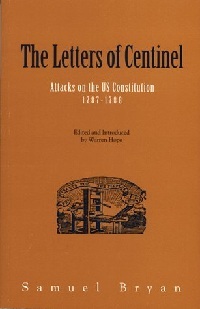 Centinel
Centinel
1787-1788
“Centinel” was an alias used to write a series of 18 articles that were printed in The Philadelphia Independent Gazetteer and The Philadelphia Freeman’s Journal between October 5, 1787, and April 9, 1788.
It is generally accepted by historians that the majority of these articles were written by Samuel Bryan. However, some may have been written by Eleazer Oswald of The Independent Gazetteer.
Source: http://en.wikipedia.org/wiki/Letters_of_Centinel
 Bibliography
Bibliography
Press your browser’s BACK button to return to the previous page.
 Miguel de Cervantes Saavedra
Miguel de Cervantes Saavedra
1547-1616
Miguel de Cervantes Saavedra was born in Alcala de Henares in the old kingdom of Toledo, Spain. His birth date is unknown but a record states that he was christened on October 9, 1547.
Nothing is known of Cervantes’ life until 1569. In that year, Juan Lopez de Hoyos, a humanist teacher who was devoted to literary culture and whose ideas emphasized nonreligious concerns, brought out a volume in memory of the death of Queen Isabel de Valois in 1568. Cervantes contributed three poems to this work and Lopez de Hoyos wrote of him as “our dear and beloved pupil.” Since Lopez de Hoyos was an admirer of the Dutch humanist Erasmus, Cervantes’ attitudes about religion and his admiration toward Erasmus is reflected in his works. Other than the probable likelihood that he studied with the Jesuits in Seville, Spain, that is all that is known about his education.
In 1570, Cervantes joined the Spanish forces at Naples, Italy. At this time, the Ottoman Empire and the Mediterranean countries were at war over control of land and power. As a soldier he witnessed the naval victory at the Gulf of Lepanto, Greece, on October 7, 1571. Aboard the Marquesa, in the thick of the battle, he was wounded twice in the chest and once in the left hand. The last wound maimed his hand for life. Cervantes often mentioned this victory in his works.
While in Tomar, Portugal, in 1581, Cervantes was given money to accomplish a royal mission to Oran. This he did, but the royal service was not very rewarding. About this same time, Cervantes turned to writing for the theater, an activity that guaranteed a certain income if the plays were successful. In the Adjunta to his Viaje del Parnaso (1614) and in the prologue to his Ocho comedias y ocho entremeses (1615), he tells of his dramatic successes and his eventual downfall. In a manuscript discovered in 1784, it was learned that of these early plays only two have survived: Los tratos de Argel and La Numancia.
In 1587, Cervantes was in Seville, Spain. The war between Spain and England was gearing up. The preparation of the Spanish Armada for its disastrous expedition against England was happening on a grand scale. But his new post as commander of the navy brought him only grief, shame and discomfort. As he had before, he turned to the theater for financial help. Cervantes agreed to write six plays, but payment would be withheld if the producer did not find each of the plays to be “one of the best ever produced in Spain.” Nothing is known of the outcome of this contract. For the next seven years, Cervantes was in and out of jail for bad financial deals.
Little documentation for the years from 1600 to 1603 exists. It is very probable that Cervantes was jailed again for financial reasons. Most of his time must have been taken up by the writing of Don Quixote. In January 1605, Don Quixote was published in Madrid. It was an immediate success.
When Cervantes was 65 years old he entered a period of extraordinary literary creativity. His Novelas ejemplares were published in Madrid in 1613. They are 12 little masterpieces, with which Cervantes created the art of short story writing in Spain.
In 1614, his poem, “Viaje del Parnaso,” was published. Later in 1615 Cervantes published his own second part of Don Quixote. Cervantes then put all of his energy into finishing Los trabajos de Persiles y Sigismunda, a novel of adventures. He had probably begun it at the turn of the century. He signed the dedication to the Count of Lemos (dated April 19, 1616) on his deathbed.
He died four days later in Madrid.
Source: http://www.notablebiographies.com/Ca-Ch/Cervantes-Miguel-de.html
 Bibliography
Bibliography
Press your browser’s BACK button to return to the previous page.
 Wu Ch’eng-en
Wu Ch’eng-en
c. 1500-1582
Wu Cheng’en (ca. 1500-1582) was a Chinese novelist and poet of the Ming Dynasty, best known for being the attributed author of Journey to the West.
Wu was born in Lianshui, in Jiangsu province, and later moved to nearby Huaian. Wu’s father, Wu Rui, had had a good primary education and “shown an aptitude for study,” but ultimately spent his life as an artisan because of his family’s financial difficulties. Nevertheless, Wu Rui continued to “devote himself to literary pursuits” and, as a child, Wu acquired the same enthusiasm for literature – including classical literature, popular stories and anecdotes.
He took the imperial examinations several times in attempt to become a mandarin, or imperial, official but never passed and did not gain entry into the imperial university in Nanjing until middle age; after that, he did become an official and had postings in both Beijing and Changxing County, but he did not enjoy his work and eventually resigned, probably spending the rest of his life writing stories and poems in his hometown.
During this time he became an accomplished writer, producing both poetry and prose, and became friends with several prominent contemporary writers. Wu remained poor throughout his life, however, and did not have any children; dissatisfied with the political climate of the time and with the corruption of the world, he spent much of his life as a hermit.
Wu is best known for writing Journey to the West, one of the Four Great Classical Novels of Chinese literature. Wu is widely thought to have published the work in anonymity due to the social pressures at the time. At the time when Wu lived, there was a trend in Chinese literary circles to imitate the classical literature of the Qin, Han and Tang dynasties, written in Classical Chinese; late in life, however, Wu went against this trend by apparently writing the novel, Journey to the West, in the vernacular tongue.
In addition to Journey to the West, Wu wrote numerous poems and stories (including the novel Yuding Animals, which includes a preface by Wu), although most have been lost. Some of his work survives because, after his death, a family member gathered as many manuscripts as he could find and compiled them into four volumes, entitled Remaining Manuscripts of Mr. Sheyang.
Source: http://en.wikipedia.org/wiki/Wu_Cheng%27en
 Bibliography
Bibliography
Press your browser’s BACK button to return to the previous page.
 Patrick Chamoiseau
Patrick Chamoiseau
1953-
Patrick Chamoiseau is a French author from Martinique known for his work in the creolite movement.
Chamoiseau was born on December 3, 1953 in Fort-de-France, Martinique, where he currently resides. After he studied law in Paris he returned to Martinique inspired by Edouard Glissant to take a close interest in Creole culture.
Chamoiseau is the author of a historical work on the Antilles under the reign of Napoleon Bonaparte and several nonfiction books, including Eloge de la creolite (In Praise of Creoleness), co-authored with Jean Bernabe and Raphael Confiant. His novel, Texaco, was awarded the Prix Goncourt in 1992 and was chosen as a New York Times Notable Book of the Year.
Chamoiseau may also safely be considered as one of the most innovative writers to hit the French literary scene since Louis-Ferdinand Celine. His freeform use of French language – a highly complex yet fluid mixture of constant invention and “creolism” – fuels a poignant and sensuous depiction of Martinique people in particular and humanity at large.
Source: http://en.wikipedia.org/wiki/Patrick_Chamoiseau
 Bibliography
Bibliography
Press your browser’s BACK button to return to the previous page.
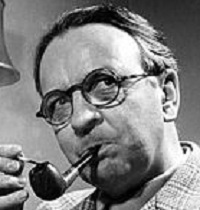 Raymond Chandler
Raymond Chandler
1888-1959
Raymond Thornton Chandler (July 23, 1888-March 26, 1959) was an American novelist and screenwriter.
Chandler was born in Chicago, Illinois, in 1888, but spent his early years in Plattsmouth, Nebraska, living with his mother and father near his cousins, maternal aunt and uncle. After Chandler’s family were abandoned by his father, an alcoholic civil engineer who worked for the railway, and to obtain the best possible education for Ray, his mother moved them to London, England, in 1900. Another uncle, a successful Quaker lawyer in Waterford, supported them, while they lived with his maternal grandmother.
Chandler was classically educated at Dulwich College. He spent some of his childhood summers in Waterford with his maternal family. He did not attend university, instead spending time in Paris and Munich improving his foreign language skills. In 1907, he was naturalized as a British subject in order to take the civil service examination, which he passed, and then took an Admiralty job, lasting a year. His first poem was published during that time. Chandler regained his U.S. citizenship in 1956.
Chandler disliked the servility of the civil service and resigned, to the consternation of his family, and became a reporter for The Daily Express and The Bristol Western Gazette newspapers. He was an unsuccessful journalist, published reviews and continued writing romantic poetry.
In 1912, he borrowed money from his Waterford uncle, who expected it to be repaid with interest, and returned to America, visiting his aunt and uncle before settling in San Francisco for a time, where he took a correspondence bookkeeping course, finishing ahead of schedule. His mother joined him in late 1912 and they moved to Los Angeles in 1913. In 1917, when the U.S. entered World War I, he enlisted in the Canadian Expeditionary Force, saw combat in the trenches in France with the Gordon Highlanders and was undergoing flight training in the fledgling Royal Air Force (RAF) when the war ended.
Due to his meager financial circumstances during the Depression, Chandler turned to his latent writing talent to earn a living. Chandler’s first professional work, “Blackmailers Don’t Shoot,” was published in Black Mask magazine in 1933; his first novel, The Big Sleep, was published in 1939, featuring his famous Philip Marlowe detective character speaking in the first person.
His second Marlowe novel, Farewell, My Lovely (1940), became the basis for three movie versions adapted by other screenwriters, including 1944’s Murder My Sweet. Literary success and film adaptations led to a demand for Chandler himself as a screenwriter. He and Billy Wilder co-wrote Double Indemnity (1944), based on James M. Cain’s novel of the same name. Chandler’s only original screenplay was The Blue Dahlia (1946). Chandler also collaborated on the screenplay of Alfred Hitchcock’s Strangers on a Train (1951).
In 1946, Chandler moved to La Jolla, California, an affluent coastal neighborhood of San Diego, where he wrote the final two Philip Marlowe novels, The Long Goodbye and his last completed work, Playback. Chandler’s final Marlowe short story, circa 1957, was entitled “The Pencil.”
Chandler’s loneliness worsened his propensity for clinical depression; he returned to drink, never quitting it for long, and the quality and quantity of his writing suffered. After a respite in England, he returned to La Jolla. He died at Scripps Memorial Hospital of pneumonial peripheral vascular shock and prerenal uremia in 1959.
Source: http://en.wikipedia.org/wiki/Raymond_Chandler
 Bibliography
Bibliography
Press your browser’s BACK button to return to the previous page.
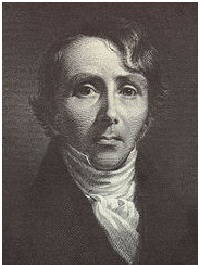 William Ellery Channing
William Ellery Channing
1780-1842
Dr. William Ellery Channing (April 7, 1780-October 2, 1842) was the foremost Unitarian preacher in the United States in the early 19th century and, along with Andrews Norton, one of Unitarianism’s leading theologians. He was known for his articulate and impassioned sermons and public speeches, and as a prominent thinker in the liberal theology of the day. Channing’s religion and thought were among the chief influences on the New England Transcendentalists, though he never countenanced their views, which he saw as extreme.
Channing was born in Newport, Rhode Island, a grandson of William Ellery, a signer of the United States Declaration of Independence. Channing became a New England liberal, rejecting the Calvinist doctrines of total depravity and divine election.
Channing enrolled at Harvard College at a troubled time, particularly because of the recent French Revolution. He graduated in 1798 and was elected commencement speaker, though Harvard faculty prohibited him from mentioning the Revolution and other political discussions.
In opposition to traditional American Calvinist orthodoxy, Channing preferred a gentle, loving relationship with God. In 1803, Channing was called as pastor of the Federal Street Church in Boston, where he remained for the rest of his life. He lived through the increasing tension between religious liberals and conservatives and took a moderate position, rejecting the extremes of both groups.
Nevertheless, he became the primary spokesman and interpreter of Unitarianism when he preached the ordination sermon of Jared Sparks in Baltimore in 1819; it was entitled “Unitarian Christianity.” In that address, he explicated the distinctive tenets of the Unitarian movement, only one of which was the rejection of the Trinity. Other important tenets were the belief in human goodness and the subjection of theological ideas to the light of reason.
In 1828 he gave another famous ordination sermon, entitled “Likeness to God.” The idea of the human potential to be like God, which Channing advocated as grounded firmly in scripture, was seen as heretical by the Calvinist religious establishment of his day. It is in this address that Channing first advocates the possibility for revelation through reason rather than solely from scripture.
In later years, Channing addressed the topic of slavery, although he was never an ardent abolitionist. In 1835, Channing wrote the book entitled Slavery. However, he held a common American belief about the inferiority of African slaves and held a belief that, once freed, Africans would need overseers. The overseers (largely former slave masters) were necessary because the slaves would lapse into laziness. Furthermore, he did not join the abolitionist movement because he did not agree with their way of conducting themselves, and he felt that voluntary associations limited a person’s autonomy. Therefore, he often chose to remain separate from organizations and reform movements. This middle position characterized his attitude about most questions, although his eloquence and strong influence on the religious world incurred the enmity of many extremists. Channing had an enormous influence over the religious (and social) life of New England, and America, in the 19th century.
Channing died in Old Bennington, Vermont, where a cenotaph is placed in his memory. He is buried in Mount Auburn Cemetery, Cambridge, Massachusetts.
Source: http://en.wikipedia.org/wiki/William_Ellery_Channing
 Bibliography
Bibliography
Press your browser’s BACK button to return to the previous page.
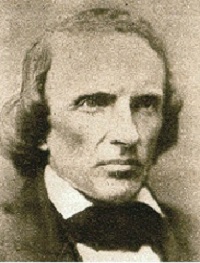 William Henry Channing
William Henry Channing
1810-1884
William Henry Channing (May 25, 1810-December 23, 1884) was an American Unitarian clergyman, writer and philosopher.
Channing was born in Boston, Massachusetts. Channing’s father died when he was an infant and responsibility for the young man’s education was assumed by his uncle, William Ellery Channing, the pre-eminent Unitarian theologian of the early 19th century. The younger William graduated from Harvard College in 1829 and from Harvard Divinity School in 1833. He was ordained and installed over the Unitarian church in Cincinnati in 1835. He became warmly interested in the schemes of Charles Fourier and others for social reorganization.
He moved to Boston about 1847, afterward to Rochester, New York, and to New York City where, both as preacher and editor, he became a leader in a movement of Christian socialism. As an early supporter of the socialistic movement in this country, he was editor of the Present, The Spirit of the Age and The Harbinger. In 1848, he presided over The Religious Union of Associationists in Boston, a socialist group that included many members of the Brook Farm commune. In 1857, he succeeded James Martineau as minister of the Hope Street Unitarian Chapel, Liverpool, England.
At the commencement of the American Civil War, he returned (1862) and took charge of the Unitarian church in Washington, D.C. Channing, along with the younger Ellery Channing, was a Transcendentalist. He was a prolific writer, contributing to The North American Review, The Dial, The Christian Examiner and other serials. He was a member of the Transcendental Club and corresponded with Ralph Waldo Emerson.
Channing was, in 1863 and 1864, the Chaplain of the United States House of Representatives. He died in London.
Source: http://en.wikipedia.org/wiki/William_Henry_Channing
 Bibliography
Bibliography
Press your browser’s BACK button to return to the previous page.
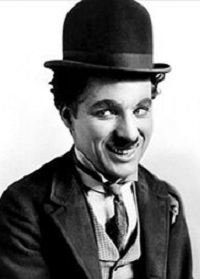 Charles Chaplin
Charles Chaplin
1889-1977
Sir Charles Spencer “Charlie” Chaplin (April 16, 1889-December 25, 1977) was an English comic actor, film director and composer best known for his work during the silent film era. He became the most famous film star in the world before the end of World War I. Chaplin used mime, slapstick and other visual comedy routines and continued well into the era of the talkies, though his films decreased in frequency from the end of the 1920s.
His most famous role was that of The Tramp, which he first played in the Keystone comedy, Kid Auto Races at Venice, in 1914. From the April 1914 one-reeler, Twenty Minutes of Love, onward he was writing and directing most of his films. By 1916, he was also producing them and, from 1918, he was even composing the music for them. With Mary Pickford, Douglas Fairbanks and D.W. Griffith, he co-founded United Artists in 1919.
His working life in entertainment spanned over 75 years, from the Victorian stage and the music hall in the United Kingdom as a child performer, until close to his death at the age of 88. His high-profile public and private life encompassed both adulation and controversy.
In 1999, the American Film Institute ranked Chaplin the 10th greatest male screen legend of all time.
Source: http://en.wikipedia.org/wiki/Charlie_Chaplin
 Bibliography
Bibliography
Press your browser’s BACK button to return to the previous page.
 George Chapman
George Chapman
1559-1634
George Chapman was born in Hitchen, a country town near London. He may have attended Oxford, although he claimed to have been self-taught. He spent a few years in the household of a nobleman and in 1591-1592 was engaged in military service on the Continent.
Chapman became an important literary figure with the publication of his first work, The Shadow of Night (1594). Chapman’s reputation as a man of letters was firmly established by Ovid’s Banquet of Sense (1595) and his continuation of Christopher Marlowe’s Hero and Leander (1598), both of them amatory, erotic poems in the vein of Shakespeare’s Venus and Adonis (1593).
He began writing for the stage about 1595 and, in the following 10 years, composed a number of comedies, including A Humorous Day’s Mirth (1597). Chapman’s best-known dramatic work, however, is the heroic tragedy Bussy D’Ambois (1604). The Revenge of Bussy D’Ambois was a sequel written some six years later.
Despite his success as a poet and a dramatist, Chapman led a very insecure existence. In 1600 he was imprisoned for debt and, in 1605, he suffered the same punishment for his part in Eastward Ho!, a play written in collaboration with Jonson and John Marston.
Chapman’s literary energies after 1613 were devoted almost exclusively to his monumental translation of Homer, which he had begun many years earlier and considered his most significant literary achievement.
Chapman died on May 12, 1634.
Source: http://www.answers.com/topic/george-chapman
 Bibliography
Bibliography
Press your browser’s BACK button to return to the previous page.
 Bruce Chatwin
Bruce Chatwin
1940-1989
Charles Bruce Chatwin (May 13, 1940-January 18, 1989) was an English novelist and travel writer. He won the James Tait Black Memorial Prize for his novel, On the Black Hill (1982). Married and bisexual, he was one of the first prominent men in Britain known to have contracted HIV and died of AIDS, although he hid the facts of his illness.
Bruce Chatwin was born in the Shearwood Road nursing home in Sheffield, England, and his first home was his grandparents’ house in Dronfield, near Sheffield. His mother, Margharita (nee Turnell), had moved back to her parents’ home when Chatwin’s father, Charles Chatwin, went away to serve with the Royal Naval Reserve. Chatwin spent his early childhood living with his parents in West Heath in Birmingham (then in Warwickshire), where his father had a law practice. He was educated at Marlborough College in Wiltshire.
In 1972, Chatwin was hired by The Sunday Times Magazine as an adviser on art and architecture. His association with the magazine cultivated his narrative skills. Chatwin travelled on many international assignments, writing about such subjects as Algerian migrant workers and the Great Wall of China, and interviewing such diverse people as Andre Malraux in France and the poet Nadezhda Mandelstam in the Soviet Union.
In 1972, Chatwin interviewed the 93-year-old architect and designer Eileen Gray in her Paris salon, where he noticed a map of the area of South America called Patagonia, which she had painted. “I’ve always wanted to go there,” Bruce told her. “So have I,” she replied. “Go there for me.” Two years later, in November 1974, Chatwin flew out to Lima, Peru, and reached Patagonia a month later. When he arrived, he left the newspaper with a telegram: “Have gone to Patagonia.” He spent six months in the area, a trip that resulted in the book, In Patagonia (1977). This work established his reputation as a travel writer.
Later works included a novel based on the slave trade, The Viceroy of Ouidah, which he researched with extended stays in Benin, West Africa. For his book, The Songlines (1987), a work combining fiction and nonfiction, Chatwin went to Australia. Winner of the James Tait Black Memorial Prize, his novel, On the Black Hill (1982), was set closer to home, in the hill farms of the Welsh Borders. Utz (1988) was a novel about the obsession that leads people to collect.
He died in Nice in 1989 at age 48.
Source: http://en.wikipedia.org/wiki/Bruce_Chatwin
 Bibliography
Bibliography
Press your browser’s BACK button to return to the previous page.
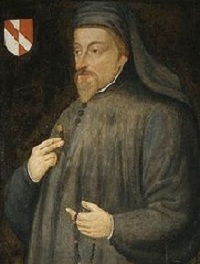 Geoffrey Chaucer
Geoffrey Chaucer
c. 1343-1400
Geoffrey Chaucer (c. 1343-October 25, 1400), known as the Father of English literature, is widely considered the greatest English poet of the Middle Ages and was the first poet to have been buried in Poet’s Corner in Westminster Abbey. While he achieved fame during his lifetime as an author, philosopher, alchemist and astronomer, as well as composing a scientific treatise on the astrolabe for his 10-year-old son Lewis, Chaucer also maintained an active career in the civil service as a bureaucrat, courtier and diplomat. Among his many works, which include The Book of the Duchess, The House of Fame, The Legend of Good Women and Troilus and Criseyde, he is best known today for The Canterbury Tales. Chaucer is a crucial figure in developing the legitimacy of the vernacular, Middle English, at a time when the dominant literary languages in England were French and Latin.
Chaucer was born in London sometime around 1343, though the precise date and location of his birth remain unknown. Chaucer probably studied law in the Inner Temple (an Inn of Court). He became a member of the royal court of Edward III as a varlet de chambre, yeoman or esquire on June 20, 1367, a position that could entail a wide variety of tasks. His wife also received a pension for court employment.
A possible indication that his career as a writer was appreciated came when Edward III granted Chaucer “a gallon of wine daily for the rest of his life” for some unspecified task. This was an unusual grant but, given on a day of celebration, St. George’s Day 1374, when artistic endeavors were traditionally rewarded, it is assumed to have been another early poetic work. It is not known which, if any, of Chaucer’s extant works prompted the reward, but the suggestion of him as poet to a king places him as a precursor to later poets laureate. Chaucer continued to collect the liquid stipend until Richard II came to power, after which it was converted to a monetary grant on April 18, 1378.
Chaucer obtained the very substantial job of Comptroller of the Customs for the port of London, which he began on June 8, 1374. While still working as comptroller, Chaucer appears to have moved to Kent, being appointed as one of the commissioners of peace for Kent, at a time when French invasion was a possibility. He is thought to have started work on The Canterbury Tales in the early 1380s. He also became a Member of Parliament for Kent in 1386.
He is believed to have died of unknown causes on October 25, 1400, but there is no firm evidence for this date, as it comes from the engraving on his tomb, erected more than 100 years after his death.
Source: http://en.wikipedia.org/wiki/Geoffrey_Chaucer
 Bibliography
Bibliography
Press your browser’s BACK button to return to the previous page.
 Sidney (Paddy) Chayefsky
Sidney (Paddy) Chayefsky
1923-1981
Sidney Aaron “Paddy” Chayefsky (January 29, 1923-August 1, 1981) was an American playwright, screenwriter and novelist. He is the only person to have won three solo Academy Awards for Best Screenplay.
He was born in the Bronx, New York, to Ukrainian Jewish parents, Harry and Gussie Stuchevsky Chayefsky. He attended DeWitt Clinton High School and then the City College of New York. While there, he played for the semi-professional football team, Kingsbridge Trojans. He graduated with a degree in accounting and then studied languages at Fordham University.
Chayefsky’s early stories were notable for their dialogue, their depiction of second-generation Americans and their sentiment and humor.
He was considered one of the most renowned dramatists of the so-called Golden Age of Television. His intimate, realistic scripts provided a naturalistic style of television drama for the 1950s and he was regarded as the central figure in the “kitchen sink realism” movement of American television.
Following his critically acclaimed teleplays, Chayefsky continued to succeed as a playwright and novelist. As a screenwriter, he received three Academy Awards for Marty (1955), The Hospital (1971) and Network (1976).
Source: http://en.wikipedia.org/wiki/Paddy_Chayefsky
 Bibliography
Bibliography
Press your browser’s BACK button to return to the previous page.
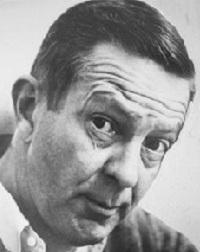 John Cheever
John Cheever
1912-1982
John William Cheever (May 27, 1912-June 18, 1982) was an American novelist and short story writer. He is sometimes called “the Chekhov of the suburbs.” His fiction is mostly set in the Upper East Side of Manhattan, the Westchester suburbs, old New England villages based on various South Shore towns around Quincy, Massachusetts, where he was born, and Italy, especially Rome. While Cheever is perhaps best remembered for his short stories (including “The Enormous Radio,” “Goodbye, My Brother,” “The Five-Forty-Eight,” “The Country Husband” and “The Swimmer”), he also wrote a number of novels, such as The Wapshot Chronicle (1958), The Wapshot Scandal (1965), Bullet Park (1969) and Falconer (1977).
His main themes include the duality of human nature – sometimes dramatized as the disparity between a character’s decorous social persona and inner corruption, and sometimes as a conflict between two characters (often brothers) who embody the salient aspects of both, light and dark, flesh and spirit. Many of his works also express a nostalgia for a vanishing way of life (as evoked by the mythical St. Botolphs in the Wapshot novels), characterized by abiding cultural traditions and a profound sense of community, as opposed to the alienating nomadism of modern suburbia.
A compilation of his short stories, The Stories of John Cheever, won the 1979 Pulitzer Prize for Fiction and the National Book Critics Circle Award. On April 27, 1982, six weeks before his death, Cheever was awarded the National Medal for Literature by the American Academy of Arts and Letters. His work has been included in the Library of America.
In the summer of 1981, a tumor was discovered in Cheever’s right kidney and, in late November, he returned to the hospital and learned that the cancer had spread to his femur, pelvis and bladder. Cheever’s last novel, Oh What a Paradise It Seems, was published in March 1982; only 100 pages long and relatively inferior (as Cheever himself suspected). He died on June 18, 1982.
Source: http://en.wikipedia.org/wiki/John_Cheever
 Bibliography
Bibliography
Press your browser’s BACK button to return to the previous page.
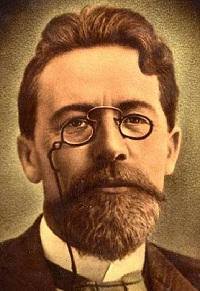 Anton Chekhov
Anton Chekhov
1860-1904
Anton Pavlovich Chekhov was born in Taganrog in South Russia on the Azov Sea on January 17, 1860. In August 1879, he moved to Moscow and entered the medical school of Moscow University. After graduating in 1884, he went to work in the hospital at Chikino, Russia, but by December of that year he had begun coughing up blood – the first symptom of the tuberculosis that eventually caused his death.
In an attempt to add to his income in Moscow, Chekhov wrote for the humor magazines he himself liked to read. His first story was published in March 1880 by a magazine called The Dragonfly, which went on to publish nine more of his stories. In the fall of 1881, he had stories accepted by The Alarm Clock and a new humor magazine, The Spectator. His first book was self-published, The Tales of Melpomene, a collection of six humor pieces in 1884. Chekhov’s first book published by someone else, Motley Stories, came out in 1886. In the Twilight, a collection of short stories, appeared in August. Chekhov’s first completed play, Ivanov, was produced in Moscow in November 1887.
“The Steppe” (1888) began a new phase in Chekhov’s writing career. Not only was it accepted by the high-class Northern Messenger magazine – bringing Chekhov a considerable sum of money – but it also was highly praised by other famous writers. In October 1888, he won the Academy of Sciences’ Pushkin Prize. “The Lights,” “The Name-Day Party” and “An Attack of Nerves” all appeared in this year. These were followed by “A Dreary Story” (1889) and another collection of stories, Children (1889). In March 1890, his seventh book, a collection of stories entitled Gloomy People, appeared.
Chekhov’s play, The Sea Gull, had failed in its first presentation in 1896 but in 1898, in the new Moscow Art Theater, it was such a spectacular success that the gull became, and remains, the theater’s official emblem. Chekhov’s other great plays followed quickly: Uncle Vanya (1897); Three Sisters (1900-01); and The Cherry Orchard (1903-04).
Chekhov’s health worsened in 1904 and his doctors told him that he had to go to a hospital. In June 1904, he set off for Badenweiler, Germany. On July 2, 1904, he died in a hotel at Badenweiler.
Source: http://www.notablebiographies.com/Ch-Co/Chekhov-Anton.html
 Bibliography
Bibliography
Press your browser’s BACK button to return to the previous page.
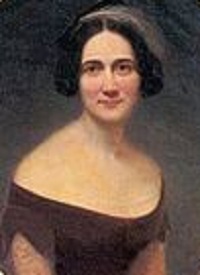 Mary Boykin Chesnut
Mary Boykin Chesnut
1823-1886
Mary Boykin Chesnut, born Mary Boykin Miller (March 31, 1823-November 22, 1886), was a South Carolina author noted for a book published as her Civil War diary, a “vivid picture of a society in the throes of its life-and-death struggle.” She described the war from within her upper-class circles of Southern planter society, but encompassed all classes in her book. She was married to a lawyer who served as a United States senator and Confederate officer.
Chesnut worked toward a final form of her book in 1881-1884, based on her extensive diary written during the war years. It was published after her death in 1905. New versions were published after her papers were discovered, in 1949, by the novelist Ben Ames Williams, and in 1981, by the historian C. Vann Woodward. His annotated edition of the diary, Mary Chesnut’s Civil War (1981), won the Pulitzer Prize for history in 1982. Literary critics have called Chesnut’s diary “a work of art” and the most important work by a Confederate author.
She was born on March 31, 1823, on her maternal grandparents’ plantation, called Mount Pleasant, near Stateburg, South Carolina, in the High Hills of Santee. Her parents were Mary Boykin (1804-85) and Stephen Decatur Miller (1788-1838), who had served as a U.S. Representative. In 1829, he was elected governor of South Carolina and in 1831 as a U.S. Senator. The family then lived in Charleston. Mary was the oldest of four children.
At age 12, she began her formal education in Charleston, where she boarded at Mme. Talvande’s French School for Young Ladies, which attracted daughters from the elite of the planter class. She became fluent in French and German, and received a strong education.
Leaving politics, her father took his family to Mississippi, where he bought extensive acreage. It was a crude, rough frontier compared to Charleston. He owned three cotton plantations and hundreds of slaves. Mary lived in Mississippi for short periods between school terms but was much more fond of the city.
In 1836, while in Charleston, 13-year-old Mary met her future husband, James Chesnut Jr. (1815-85), who was eight years her senior. Her parents at first opposed his suit but, at 16, Mary began to take an interest in the young man. At age 17, she married Chesnut on April 23, 1840. They first lived with his parents and sisters at Mulberry, their plantation outside Camden, South Carolina.
In 1858, by then an established lawyer and politician, James Chesnut Jr. was elected a U.S. Senator from South Carolina and served as such until South Carolina’s secession from the Union in 1860. Once the Civil War broke out, Chesnut became an aide to President Jefferson Davis and was commissioned a brigadier general in the Confederate Army.
Intelligent and witty, Mary Chesnut took part in her husband’s career, as entertaining was an important part of building political networks. She had her best times when they were in the capitals of Washington, D.C., and Richmond. She suffered from depression, in part because of her inability to have children.
Examination of Chesnut’s papers has revealed the history of her development as a writer and of her work on the diary as a book. Before working to revise her diary in the 1880s, Chesnut wrote a translation of French poetry, essays and a family history. She also wrote two full novels that she never published: The Captain and the Colonel, completed about 1875, and Two Years of My Life, finished about the same time. At the time of her death she had finished most of a draft of a third long novel, called Manassas.
Source: http://en.wikipedia.org/wiki/Mary_Boykin_Chesnut
 Bibliography
Bibliography
Press your browser’s BACK button to return to the previous page.
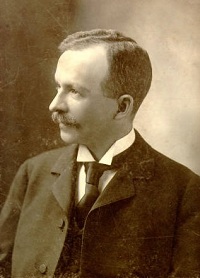 Charles W. Chesnutt
Charles W. Chesnutt
1858-1932
Charles Waddell Chesnutt (June 20, 1858-November 15, 1932) was an American author, essayist, political activist and lawyer, best known for his novels and short stories exploring complex issues of racial and social identity in the post-Civil War South, where the legacy of slavery and interracial relations had resulted in many free people of color who had attained education before the war, as well as slaves and freedmen of mixed race.
Chesnutt was born in Cleveland, Ohio, to Andrew Chesnutt and Ann Maria (Sampson) Chesnutt, both “free persons of color” from Fayetteville, North Carolina. His paternal grandfather was known to be a white slaveholder and, based on his appearance, Chesnutt likely had other white ancestors. He claimed to be seven-eighths white, although he identified as African-American. Chesnutt could “pass” with relative ease for a white man, although he never chose to do so. In the 18th century and in many Southern states at the time of his birth, Chesnutt was considered legally white. Under the “one-drop rule” that became adopted in the 1920s in most of the South, he was classified as “legally” black.
After the Civil War, the Chesnutt family returned to Fayetteville when Charles was nine years old. His parents ran a grocery store but it failed because of Andrew Chesnutt’s poor business practices and the struggling economy of the postwar South. By age 13, Charles was a pupil-teacher at the Howard School, one of many founded for Black students by the Freedmen’s Bureau during the Reconstruction era.
Chesnutt continued to study and teach. He eventually was promoted to assistant principal of the normal school in Fayetteville, one of a number of historically Black colleges established for the training of Black teachers. It has developed into Fayetteville State University.
In 1878, Chesnutt married Susan Perry and moved to Cleveland. There, Chesnutt studied for and passed the bar exam in 1887. Chesnutt also began writing stories that were accepted by top-ranked national magazines. These included The Atlantic Monthly, which in August 1887 published his first short story, “The Goophered Grapevine.” His first book was a collection of short stories, The Conjure Woman, published in 1899. These stories featured black characters who spoke in dialect, as was popular in much Southern literature at the time.
Chesnutt continued writing short stories. He also completed a biography of the abolitionist Frederick Douglass, who had escaped from slavery before the war. He began to write novels and reflected his stronger sense of activism. His book, Marrow of Tradition, was based on the Wilmington Massacre of 1898, when whites took over the city and threw out the elected bi-racial government. Chesnutt wrote several novels and appeared on the national lecture circuit, primarily in Northern states.
Chesnutt contributed some short stories and essays to the NAACP’s official magazine, The Crisis, founded in 1910. He did not receive compensation for the publication of these pieces. In 1917, Chesnutt protested and successfully shut down showings in Ohio of the controversial film, Birth of a Nation, which the NAACP officially protested across the nation.
Chesnutt died on November 15, 1932, at the age of 74. He was interred in Cleveland’s Lake View Cemetery.
Source: http://en.wikipedia.org/wiki/Charles_W._Chesnutt
 Bibliography
Bibliography
Press your browser’s BACK button to return to the previous page.
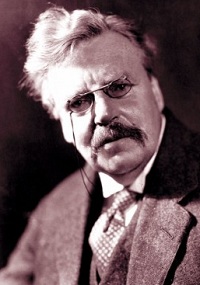 G.K. Chesterton
G.K. Chesterton
1874-1936
Gilbert Keith Chesterton was born in London in 1874. He was educated at St. Paul’s School and Slade Art School. Chesterton lost interest in art and instead began writing articles for newspapers and journals such as The Daily News, The Speaker, The Bookman and The Illustrated London News.
Chesterton’s first two books were collections of poetry, The Wild Knight (1900) and Greybeards at Play (1900). This was followed by biographies of Robert Browning (1903), Charles Dickens (1906) and R.L. Stevenson (1907), as well as the popular novel, The Innocence of Father Brown (1911).
On the outbreak of World War I, Chesterton was recruited by Charles Masterman, the head of Britain’s War Propaganda Bureau (WPB), to help shape public opinion. His work included the writing of two pamphlets – “The Barbarism in Berlin” (1915) and “The Crimes of England” (1915) – and numerous articles in Britain’s newspapers.
In 1922, Chesterton became a Roman Catholic. This influenced the subject matter of his work and he published biographies of St. Francis of Assisi and St. Thomas Aquinas. G.K. Chesterton’s Collected Poems appeared in 1933. His Autobiography was published just after his death in 1936.
Source: http://www.spartacus.schoolnet.co.uk/Jchesterton.htm
 Bibliography
Bibliography
Press your browser’s BACK button to return to the previous page.
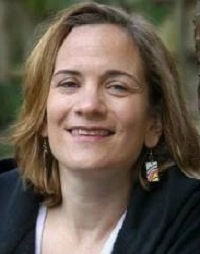 Tracy Chevalier
Tracy Chevalier
1962-
Tracy Chevalier (born in 1962 in Washington, D.C.) is a bestselling historical novelist. She lives in London with her husband and son.
Chevalier was raised in Washington, D.C., and graduated from Bethesda-Chevy Chase High School in Bethesda, Maryland. After receiving her B.A. in English from Oberlin College, she moved to England in 1984, where she worked for several years as a reference book editor. Leaving her job in 1993, she began a yearlong M.A in creative writing at the University of East Anglia.
Her career began with the book, The Virgin Blue, but she became known with her novel, Girl with a Pearl Earring, a book based on the creation of the famous painting by Vermeer.
Burning Bright, published in March 2007, concerns two children who become neighbors of William Blake in London in 1792. Her latest novel is Remarkable Creatures, based on the life of the English 19th century fossil collector, Mary Anning.
Source: http://en.wikipedia.org/wiki/Tracy_Chevalier
 Bibliography
Bibliography
Press your browser’s BACK button to return to the previous page.
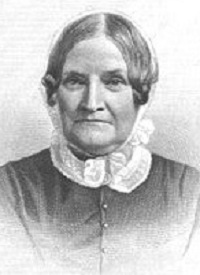 Lydia Maria Frances Child
Lydia Maria Frances Child
1802-1880
Lydia Maria Child (February 11, 1802-October 20, 1880) was an American abolitionist, women’s rights activist, opponent of American expansionism, Indian rights activist, novelist, journalist and Unitarian. Her journals, fiction and domestic manuals reached wide audiences from the 1820s through the 1850s. She at times shocked her audience, as she tried to take on issues of both male dominance and white supremacy in some of her stories. Despite these challenges, Child was later most remembered for her poem, “Over the River and Through the Woods,” about Thanksgiving.
She was born in Medford, Massachusetts, to Susannah Rand Francis and Convers Francis. Child received her education at a local dame school and later at a women’s seminary. Upon the death of her mother, she went to live with her older sister in Maine, where she studied to be a teacher. During this time, her brother, Convers, a Unitarian minister who had been educated at Harvard College and Seminary, saw to his younger sister’s education in literary masters such as Homer and Milton. She chanced to read an article in The North American Review discussing the field offered to the novelist by early New England history. Although she had never thought of becoming an author, she immediately wrote the first chapter of a novel entitled Hobomok. Encouraged by her brother’s commendation, she finished it in six weeks and published it. From this time until her death she wrote continually. She taught for one year in a seminary in Medford, and in 1824 started a private school in Watertown. In 1826, she began the publication of the Juvenile Miscellany, the first monthly periodical for children issued in the United States, and supervised it for eight years.
She taught school until 1828, when she married Boston lawyer David Lee Child. His political activism and involvement in reform introduced her to the social reforms of Indian rights and Garrisonian abolitionism.
Lydia Child and her husband began to identify themselves with the anti-slavery cause in 1831 through the personal influence and writings of William Lloyd Garrison. Child was a women’s rights activist but did not believe significant progress for women could be made until after the abolition of slavery. She believed that white women and slaves were similar in that white men held both groups in subjugation and treated them as property instead of individual human beings. Child, along with many other female abolitionists, began campaigning for equal female membership in the American Anti-Slavery Society, a controversy that later split the movement.
In 1833, her book, An Appeal in Favor of That Class of Americans Called Africans, was published. It argued in favor of the immediate emancipation of the slaves without compensation to slaveholders. She is sometimes said to have been the first white person to have written a book in support of this policy. The book was the first anti-slavery work printed in America in book form, and she followed it up with several smaller works on the same subject. Child also wrote short stories exploring through fiction the complex issues of slavery.
During the 1860s, Child wrote pamphlets about Indian rights. The most prominent, “An Appeal for the Indians” (1868), called upon government officials, as well as religious leaders, to bring justice to American Indians. Her presentation sparked Peter Cooper’s interest in Indian issues and led to the founding of the U.S. Board of Indian Commissioners and the subsequent Peace Policy in the administration of Ulysses S. Grant.
Child died in Wayland, Massachusetts, aged 78, on October 20, 1880.
Source: http://en.wikipedia.org/wiki/Lydia_Maria_Child
 Bibliography
Bibliography
Press your browser’s BACK button to return to the previous page.
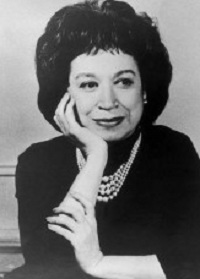 Alice Childress
Alice Childress
1912-1994
Alice Childress (October 12, 1912-August 14, 1994) was an American playwright, actor and author.
Childress was born in South Carolina but at age nine, after her parents separated, she moved to Harlem and she lived with her grandmother on 118th Street, between Lenox Avenue and Fifth Avenue. Alice attended public school in New York for her middle school and attended the Wadleigh High School for her high school education, but had to drop out after her grandmother died. She became involved in theater immediately after high school and did not attend college.
She took odd jobs, including domestic worker, photo retoucher, assistant machinist, saleslady and insurance agent. In 1939, she studied drama in the American Negro Theatre (ANT) and performed there for 11 years. She acted in Abram Hill and John Silvera’s On Strivers Row (1940), Theodore Brown’s Natural Man (1941) and Philip Yordan’s Anna Lucasta (1944). She won acclaim as an actress in numerous other productions and moved to Broadway with the transfer of ANT’s hit comedy, Anna Lucasta.
Her first play, Florence, was produced off-Broadway in 1950. Her next play, Just a Little Simple (1950), was produced in Harlem at the Club Baron Theatre. Gold Through the Trees (1952) gave her the distinction of being the first black woman to have a play produced professionally. Her next work, Wedding Band: A Love/Hate Story in Black and White, was completed in 1962.
Childress is also known for her literary works, including Those Other People (1989) and A Hero Ain’t Nothin’ but a Sandwich (1973).
Source: http://en.wikipedia.org/wiki/Alice_Childress
 Bibliography
Bibliography
Press your browser’s BACK button to return to the previous page.
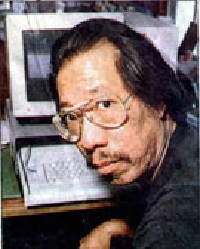 Frank Chin
Frank Chin
1940-
Frank Chin (born February 25, 1940) is an American author and playwright.
Frank Chin was born in Berkeley, California, but was raised to the age of six by a retired Vaudeville couple in Placerville, California. At six his mother brought him back to the San Francisco Bay Area to live in Oakland’s Chinatown. He attended college at the University of California, Berkeley. He received an American Book Award in 1989 for a collection of short stories and another in 2000 for Lifetime Achievement. He currently resides in Los Angeles, California.
Chin is considered to be one of the pioneers in Asian-American theatre. He founded the Asian-American Theatre Workshop, which became the Asian-American Theater Company in 1973. He first gained notoriety as a playwright in the 1970s. His play, The Chickencoop Chinaman, was the first by an Asian-American to be produced on a major New York stage. Stereotypes of Asian-Americans and traditional Chinese folklore are common themes in much of his work.
In addition to his work as an author and playwright, Frank Chin has also worked extensively with Japanese-American resisters of the draft in WWII. His novel, Born in the U.S.A., is dedicated to this subject.
Source: http://en.wikipedia.org/wiki/Frank_Chin
 Bibliography
Bibliography